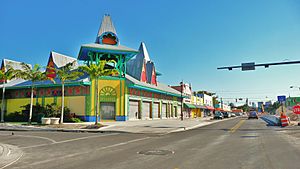Little Haiti facts for kids
Quick facts for kids
Little Haiti
|
|
|---|---|
|
Neighborhood of Miami
|
|

Caribbean Marketplace
|
|
| Nickname(s):
Lemon City (historic name)
|
|

Little Haiti neighborhood within the City of Miami
|
|
| Country | United States |
| State | Florida |
| County | Miami-Dade County |
| City | Miami |
| Elevation | 7 ft (2.1 m) |
| Population
(2010)
|
|
| • Total | 29,760 |
| • Density | 9,946/sq mi (3,840/km2) |
| Time zone | UTC-05 (EST) |
| ZIP code |
33127, 33137, 33138, 33150
|
| Area code(s) | 305, 786 |
Little Haiti (which means La Petite Haïti in French and Ti Ayiti in Haitian Creole) is a lively neighborhood in Miami, Florida, United States. It was once known by older names like Lemon City, Little River, and Edison. This area is a special home for many people who have moved from Haiti and other parts of the Caribbean.
The neighborhood is famous for its unique French and Creole influences. You can see this in its busy streets, delicious restaurants, and colorful art galleries. Little Haiti also offers exciting dance, music, and theater shows. Many family-owned businesses and other cultural activities make this place special.
A large bronze statue of General Toussaint L'Ouverture stands here. He was a very important leader in the Haitian Revolution. The statue is 13 feet tall and can be found at N Miami Avenue and 62nd Street.
Contents
History of Little Haiti
The area we now call Little Haiti was known as Lemon City for over 100 years. After the American Civil War, many people settled near Biscayne Bay. This was north of the Miami River. They built homes on land that no one officially owned yet. This is called squatting.
Some of these settlers later applied for special land grants. These grants allowed them to legally own the land they had settled on. By 1889, a community had grown with its own post office. It was first called "Motto." By 1893, the name changed to "Lemon City."
Lemon City had a school that opened in 1890. It also had several businesses and even a newspaper. There were port facilities on Biscayne Bay for boats. But when the Florida East Coast Railway reached Miami in 1896, Miami quickly became more important than Lemon City.
The name "Little Haiti" was created by Viter Juste. He was a Haitian businessman, activist, and community leader. According to a friend, Juste wrote an article for the Miami Herald. In it, he first called the neighborhood "Little Port-au-Prince."
However, the newspaper's editors thought "Little Port-au-Prince" was too long. So, they shortened the name in the headline to Little Haiti. In May 2016, city leaders in Miami officially recognized Little Haiti as a neighborhood. This happened despite some people disagreeing. Its borders now include parts of the historic Lemon City.
Neighborhood Boundaries
Little Haiti's southern edge is North (NW/NE) 54th Street. It goes west to Interstate 95. Then it moves north along the Miami city boundary to North (NW/NE) 80th Street. From there, it turns and goes back down along Northeast Second Avenue.
People in Little Haiti
In 2000, about 29,128 people lived in Little Haiti. There were 9,368 homes and 6,181 families. The average household income was about $18,887.
Most residents, about 65%, were Black or African American. About 15% were Hispanic or Latino. The Hispanic population is the fastest growing group in this area.
The neighborhood covers about 3.456 square miles (8.95 square kilometers). The average household had 3.0 people. The average family had 3.7 members.
Fun Things to Do
Delicious Food
Little Haiti is a great place to find amazing food. Many Haitian immigrants came here in the 1980s. This has created a wonderful mix of Afro-Caribbean culture and global tastes.
The restaurants here offer many different flavors and dining experiences. One famous restaurant is Boia De, which has even earned a special award from the Michelin Guide.
Vibrant Culture
NE 2nd Avenue is the main street in Little Haiti. This area is becoming a popular spot for art and culture. Nearby neighborhoods like Wynwood and the Design District are already known for their galleries.
Over the past few years, the whole area has become filled with artistic energy. People here appreciate both high-end design and street art. As prices in Wynwood and the Design District have gone up, Little Haiti, Lemon City, and Little River have become new art hotspots.
The Little Haiti Cultural Center offers many programs for the community. Next to it is The Caribbean Marketplace. This building was designed to look like traditional Haitian gingerbread houses.
Local Parks
- Athalie Range Park (named after M. Athalie Range)
- Lemon City Park between NE 58th Terrace and NE 59th Street.
- Little Haiti Soccer Park
Schools in Little Haiti
Miami-Dade County Public Schools manages all the public schools in the area. Here are some of the schools located within Little Haiti:
Public Elementary Schools
- Edison Park Elementary School
- Jesse J. McCrary Elementary School
- Morningside Elementary School
- Toussaint L'Ouverture Elementary School
Public Middle Schools
- i-tech Prep Academy
- Miami Edison Middle School
Public High Schools
- Itech @ Thomas Edison Educational Center
- Miami Edison Senior High School
Libraries for Learning
The Miami-Dade Public Library System runs all the public libraries in the area. These include:
- Lemon City Branch Library
- Edison Center Library
- Little River Library
Cultural Places to Visit
- Little Haiti Cultural Complex
- Caribbean Marketplace
- Cathedral of Saint Mary
- The Haitian Cultural Arts Alliance
Images for kids
See also
 In Spanish: Pequeña Haití para niños
In Spanish: Pequeña Haití para niños


